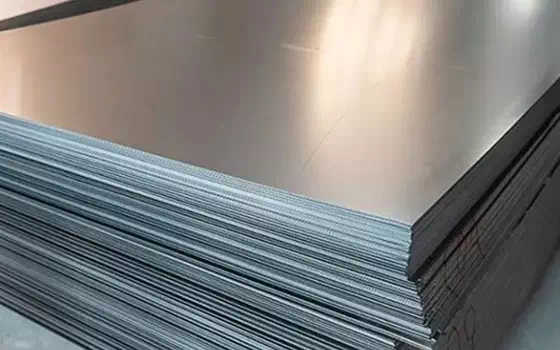Welcome to Zhishang Steel Co., Ltd.
TEL: (Gavin) +86-15665898999 | Email : info@zhishangsteel.com
Location:Home>>News>>Company News » How is stainless steel produced?

The production of stainless steel is a complex and highly streamlined process, which not only involves multiple fine process steps, but also requires precise control and optimization of each step. The following is a detailed description of its core production process and technical points:
First, crude steel smelting: alloy ratio and refining process
1. Classification of smelting methods
One-step method: hot metal directly into the argon-oxygen refining furnace (AOD), through blowing into argon-oxygen mixture gas decarbonization and adjustment of composition, suitable for low-cost production of 400 series ferritic stainless steel. This method simplifies the production process and reduces the production cost.
Two-step method: After melting scrap steel and alloy raw materials in electric arc furnace (EAF), it is transferred to AOD furnace for deep refining, which is widely used in the production of 300 series austenitic stainless steel. This method can control the alloy composition more precisely and improve the quality of the steel.
Three-step method: Vacuum decarburization furnace (VOD) is added on the basis of EAF+AOD for high-precision steel grades such as ultra-low carbon (such as 316L). This method can further reduce the carbon content of steel and improve its purity and performance.
Integrated process: Direct use of rotary kiln furnace (RKEF) treatment of laterite nickel ore, combined with AOD refining, suitable for areas rich in nickel resources. This method makes full use of local resources and reduces raw material costs.
2. Key raw materials and ratio
Chromium (Cr) : Content ≥12% is the basic corrosion resistance element, 400 series containing chromium 17%-30%. Chromium is one of the most important alloying elements in stainless steel, which determines the basic corrosion resistance of stainless steel.
Nickel (Ni) : 300 series containing nickel 8%-12%, the cost accounted for up to 70%; The low nickel 200 series is replaced with manganese. Nickel can improve the corrosion resistance and toughness of stainless steel, but the cost is higher.
Manganese (Mn) : Replacing nickel in the 200 series reduces cost, but excess will reduce corrosion resistance. Manganese is an inexpensive alloying element that can reduce production costs without compromising performance.
Second, hot rolling process: from slab to black roll
1. Rolling process
Heating: the slab (continuous casting billet) is heated to 1100-1250℃ to eliminate the casting stress. This step is to remove the stress inside the slab and make it easier for subsequent processing.
Roughing + finishing: The slab is rolled to a thickness of 3-5.5mm by multiple rolling (e.g., seven consecutive rolling mill) to form a hot-rolled black roll (surface covered with an oxide layer). This step is to process the slab to the desired thickness and shape.
Laminar cooling: the cooling rate is controlled to optimize the grain structure, and the storage is stored after winding. This step is to obtain the desired microstructure and properties.
2. Annealing and pickling
Annealing: Gas annealing furnace (such as suspension cable furnace) for austenitic stainless steel solution treatment, restore plasticity. This step is to eliminate the hardening phenomenon caused by cold working and restore the plasticity and toughness of the material.
Pickling: "mechanical descaling + sulfuric acid pre-washing + mixed acid (HNO3/HF) final washing" is used to remove the oxide skin. The total length of pickling tank can reach 136m, and the processing speed is 100m/min. This step is to remove oxides and other impurities from the surface and improve the surface quality.
Surface treatment: Scrub, spray cleaning and hot air drying to ensure surface finish. This step is to further improve the cleanliness and finish of the surface.
Third, cold rolling process: high-precision sheet manufacturing
1. Rolling and work hardening
Cold rolling mill: Using a 20-high reversing mill, the hot rolled white roll is rolled to a thickness of 0.05-3mm in 5-7 passes, and work hardening occurs during the process. This step is to further thin the hot-rolled steel sheet to the desired thickness while introducing work hardening to increase strength.
In-line annealing: recrystallization annealing (such as continuous annealing furnace) is required after cold rolling to eliminate hardening and improve ductility. This step is to eliminate the hardening phenomenon caused by cold working and restore the plasticity and toughness of the material.
2. Second pickling and leveling
Electrolytic pickling: neutral salt electrolysis combined with mixed acid cleaning to improve the surface passivation effect. This step is to further improve the cleanliness and corrosion resistance of the surface.
Flat rolling: Improve the shape and surface gloss by slight calendering (1%-3% reduction). This step is to improve the shape and surface quality of the steel plate.
4. Surface treatment and quality inspection
1. Finish the surface
Polishing/sandblasting: To improve aesthetics, commonly used in decorative stainless steel. These methods can make the surface of stainless steel smoother or have a specific texture.
Electroplating/coating: enhanced corrosion resistance, such as electrogalvanizing, spraying epoxy resin. These methods can form a protective layer on the stainless steel surface and improve its corrosion resistance.
2. Quality inspection
Non-destructive testing: eddy current inspection, ultrasonic inspection for internal defects. These methods can detect defects inside the material without damaging its structure.
Performance test: salt spray test (304 needs to pass 200 hours), flaring test to verify the processing performance. These tests can assess the corrosion resistance and processing properties of the material.
5. Special technology and environmental protection technology
1. Heat transfer technology
Continuous casting billet heat transfer: billet is not cooled directly into the mill, saving 15%-20%. This method can reduce energy consumption and production costs.
Waste gas treatment: The pickling waste gas is absorbed by the washing tower and discharged, and the acid recycling rate is 95%. This method can reduce environmental pollution and waste of resources.
2. Waste recycling
Scrap smelting: 30%-50% stainless steel scrap is added to the electric furnace to reduce raw material costs. This method can recycle waste materials and reduce production costs.
To sum up, the production of stainless steel is a process involving multiple complex steps, each of which requires precise control and optimization. With the development of technology and the improvement of environmental protection requirements, the future of stainless steel production will pay more attention to efficiency, quality and sustainability.

Zhishang Steel has always been a pioneer in custom steel and special supplies, and has been recognized for its efforts in enhancing work efficiency and product quality. In addition to ISO9001:2015 certification, we also adhere to strict quality policies and proprietary procedures. If you have any questions, please contact us to provide the best type of product solution for your pre-painted, coil coating metal process, we will closely support after-sales service to ensure that your subsequent problems can be solved in a timely manner, if you have any questions, please send email to info@zhishangsteel.com, we look forward to serving you.

Zhishang Steel, specializing in domestic steel products trade, warehousing, processing and other services. The team has four service teams: Shandong Zhishang Steel Co., LTD., Shandong Zhiyiheng Trading Co., LTD., Tai 'an Zhishang Economic and Trade Co., LTD., Shandong Zhishang Steel Structure Co., LTD. Mainly engaged in steel coil, coated, stee···